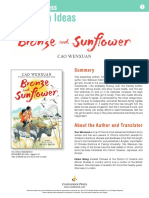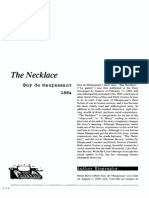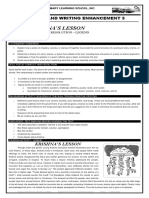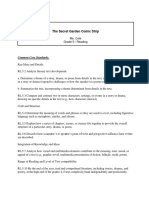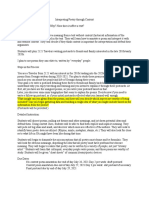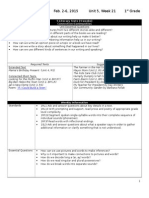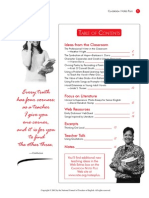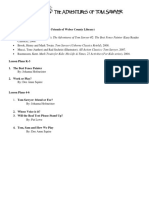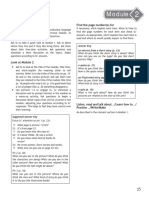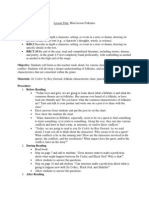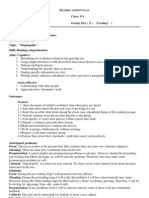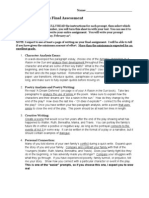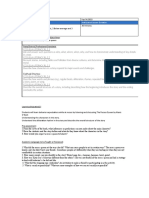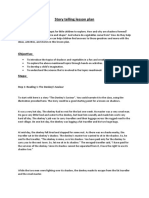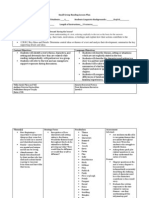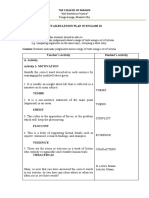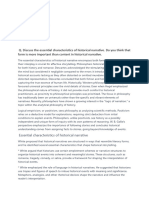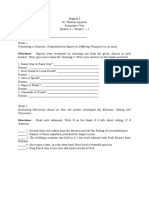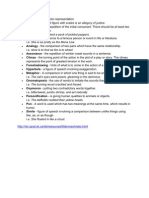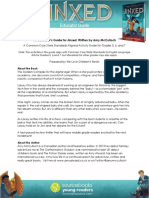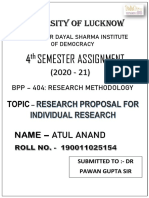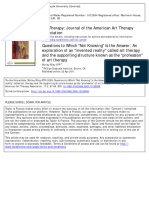2023 Unit 1 Test 1.12 Part 2
2023 Unit 1 Test 1.12 Part 2
Uploaded by
8hpjg6xxn7Copyright:
Available Formats
2023 Unit 1 Test 1.12 Part 2
2023 Unit 1 Test 1.12 Part 2
Uploaded by
8hpjg6xxn7Copyright
Available Formats
Share this document
Did you find this document useful?
Is this content inappropriate?
Copyright:
Available Formats
2023 Unit 1 Test 1.12 Part 2
2023 Unit 1 Test 1.12 Part 2
Uploaded by
8hpjg6xxn7Copyright:
Available Formats
English | Graded Assignment | Unit Test, Part 2: Understand Narrative Techniques and Structure
Name: Date:
Graded Assignment
1.12 Unit Test, Part 2: Understand Narrative Techniques and Structure
Common Core State Standards:
CCSS. ELA- Literary RL.9-10.1: Cite strong and thorough textual evidence to support analysis of what the
text says explicitly as well as inferences drawn from the text.
CCSS. ELA- Literary RL.9-10.3: Analyze how complex characters (e.g., those with multiple or conflicting
motivations) develop over the course of a text, interact with other characters, and advance the plot or develop
the theme.
CCSS.ELA- RI.9-10.2 Determine a central idea of a text and analyze its development over the course of the
text, including how it emerges and is shaped and refined by specific details; provide an objective summary of
the text.
Read each passage and the corresponding question. Write a response to each question based on the passage.
Total score: ____ of 40 points
(20 points) QUESTION 1 - “A Community Park”
Directions: Read the passage and answer the question #1 below.
A Community Park
It was Friday, and as she walked home from school, Samara thought about what she would do that
weekend. Everyone would be at the fund-raiser for new sports equipment at the high school on Saturday.
As she was trying to remember if any good movies were coming out this weekend, she noticed a group of
kids playing tag. Samara thought they looked comical running around in circles on a small plot of land
between two houses. “Well, they certainly seem happy,” thought Samara as the light turned and she
crossed the street.
On the opposite side of Cherry Street, Samara saw Mr. Peters sitting on a bench. He was reading his
newspaper as the heavy traffic of the town’s main thoroughfare whizzed by him. She wondered how he
could concentrate. Later, as she took the last turn onto her street, Samara saw her neighbor planting her
annual vegetable garden. Every year, Mrs. Yang grew eggplant, cucumbers, and bok choy, because
that’s all she had room for. “The garden looks good so far, Mrs. Yang,” Samara called.
“Thank you, dear,” Mrs. Yang said. “You know, if I had room, I would plant enough vegetables to feed the
entire neighborhood! My mother had a garden that was one square acre when I was a little girl in Korea.”
As Samara nodded and waved goodbye, she started thinking about what she had seen on her walk home
that day. She realized that Pine Grove did not have any open public spaces where everyone could go to
relax and enjoy nature. The only unused space was a vacated plot on Cedar Avenue that was completely
overgrown. Suddenly, Samara had a great idea. She decided to spend her summer campaigning for a
new community park. The only problem was that she had no idea where to start.
That evening, she went to the library and learned about what she would need to do in order to get the
idea in front of the town zoning board. It was all a little intimidating, but Wanda, the reference librarian,
helped Samara break it down into manageable steps. When Samara mentioned the Cedar Avenue plot,
Wanda’s eyes lit up. “That is a perfect spot,” Wanda said. “It’s right in the middle of town, and better yet,
the town owns it.”
Samara spent many afternoons over the next few weeks at the library with Wanda and a few other
librarians drawing up a detailed plan to present to town officials. Samara and the librarians even planned
and priced out irrigation necessary for the area that was designated as a garden. When the day of the
zoning board meeting arrived, Samara felt nervous, but Wanda and the other librarians were there for
© 2016 K12 Inc. All rights reserved. Page 1 of 7
Copying or distributing without K12’s written consent is prohibited.
English | Graded Assignment | Unit Test, Part 2: Understand Narrative Techniques and Structure
moral support. Samara thought she at least sounded confident as she presented her idea to the board.
When she finished her presentation, she was ready to wait patiently for an answer; Wanda told her that
this kind of decision might take weeks, so Samara was surprised when the board members asked her to
stay while they deliberated. The president of the board explained that Samara’s presentation had been
the last order of business for the day, and he wanted his board to be able to agree on one thing before
they left. After about 15 minutes, Samara was informed that the community park had been approved.
Samara had been telling her neighbors and friends about the park from the moment she thought of it, and
it seemed as though everyone wanted to be a part of making her vision a reality. As soon as her idea was
approved, Samara called a meeting for anyone interested in collaborating. At the meeting, residents voted
on what would be included on the land: a playset for young children and one for older children, a swing
set, several park benches, and a dog run. It was also decided that there would be a cooperative organic
vegetable garden and an herb garden at the north end of the park. Residents agreed that Mrs. Yang
would manage the gardens.
At Wanda’s suggestion, Samara asked a representative from a nearby horticultural society to come and
advise the group on the design of the park, the best native shrubs to plant, and where to put them.
Samara also asked local businesses to sponsor the park by the square foot so that the community would
be able to afford equipment and plants. Surprised by the response, Samara went to the bank to open an
account where the surplus would be saved for next spring. In a few weeks’ time, the space had been
cleared and residents were beginning to roll out sod and plant small vegetable plants and summer
flowers. By midsummer, the community was able to enjoy the new, peaceful space. Samara was happy to
have been part of creating not only a beautiful space, but a common area where residents could come
together.
___________________________________________________________
Review the narrative arc in the picture below. Think about the three problems or situations that Samara
encountered on her walk home from school at the beginning of the story. Then answer question #1.
QUESTION #1: What is the complicating incident (or main problem) in “A Community Park” and how
does it affect Samara? Describe how the problem impacts Samara’s thoughts, feelings, actions, and
interactions. Use evidence from the text to support your response. Your response should be at least one
complete paragraph. Include at least two direct quotes from the story and elaboration about those
quotes.
The graphic organizer below will help you organize the rough draft of your paragraph. You may use the
sentence starters in blue font below if you find them helpful or just delete them if they are not.
MAKE A CLAIM – This is The main problem in “A Community Park” is …
what you are going to
prove in the paragraph.
TEXT EVIDENCE. Copy and This problem affected Samara’s thoughts and feelings in many ways. For
paste a sentence or part of a example, …
sentence from the story that
explains how the problem
affected Samara’s thoughts
© 2016 K12 Inc. All rights reserved. Page 2 of 7
Copying or distributing without K12’s written consent is prohibited.
English | Graded Assignment | Unit Test, Part 2: Understand Narrative Techniques and Structure
and feelings. Put quotation
marks around the words you
copied. Transition into the
quote with a phrase such as.
Example-“At the beginning of
the story, Samara feels___
when she notices, “quote…”.
REASONING: Elaborate on This quote reveals…
your text evidence to
explain how the problem
affected Samara’s
thoughts/feelings.
TEXT EVIDENCE Copy and Secondly, this problem also affected Samara’s actions and interactions for the
paste a sentence or part of a rest of the story. For instance, …
sentence from the story that
explains how the problem
affected Samara’s actions and
interactions. Put quotation
marks around the words you
copied. Transition into the
quote with a phrase such as.
Example-“For instance,
Samara takes action to solve
the problem in the story by,
“insert quote…”.
REASONING: Elaborate on The evidence shows…
your evidence/quote above
to explain how the
problem affected Samara’s
actions by the end of the
story. In other words, what
did she do and who did she
interact with to resolve the
problem?
CONCLUDING SENTENCE – In closing, ____
Wrap up your paragraph.
Restate the claim above in
slightly different words and
give any final reflections
you have on how the
problem in the story
impacted or changed
Samara by the end of it.
© 2016 K12 Inc. All rights reserved. Page 3 of 7
Copying or distributing without K12’s written consent is prohibited.
English | Graded Assignment | Unit Test, Part 2: Understand Narrative Techniques and Structure
Copy your rough draft from the graphic organizer above and paste it below the line. Then revise
and edit your sentences to create a paragraph answer that is in a final draft format.
FINAL DRAFT Paragraph:
Grading Rubric for Question #1 (_______/ 20 points):
Criterion Advanced Proficient Basic Developing
(10 points) (8 points) (6 points) (5-0 points)
Makes a Specifically and Explains the problem or Provides a very general Does not correctly
claim and intentionally explains complicating incident in overview of the problem identify the problem in
analyzes the problem or the story. or complicating incident the story.
structure complicating incident in in the story.
of a text the story.
(10 points)
Advanced Proficient Basic Developing
(6 points) (5 points) (3 points) (2-0 points)
Uses Text- Gives sufficient Gives good evidence Gives limited evidence Gives no direct evidence
Evidence evidence from the text from the text to explain from the text to explain from the text. Paragraph
to Support to explain the problem the problem. Paragraph the problem in the story. includes no quotes.
the Claim in the story. Paragraph includes two quotes that Paragraph includes one Does not explain how the
(6 points) includes two quotes generally support the quote. Vaguely explains problem affected Samara.
that directly relate and claim. how the problem affected
support the claim. Samara.
Advanced Proficient Basic Developing
(4 points) (3 points) (2 points) (1-0 points)
Reasoning Elaborates thoroughly Gives some elaboration Gives some elaboration Gives very little or no
and after the text evidence after each quote to after the text evidence but elaboration after text
Elaboration to explain how the explain how the problem it is very general. evidence.
about Text- problem affected affected Samara.
Evidence Samara.
(4 points)
© 2016 K12 Inc. All rights reserved. Page 4 of 7
Copying or distributing without K12’s written consent is prohibited.
English | Graded Assignment | Unit Test, Part 2: Understand Narrative Techniques and Structure
(20 points) QUESTION # 2 Read the passage. Answer the question below.
My First Day on the Job
I was in full-on panic mode. Here I was on my first day as an inexperienced reporter having to cover an
important story with little guidance. I was starting to regret my decision to take the job. What was I doing
here? I wasn’t a journalism major. I didn’t have a “beat.” I didn’t even know all the rules about dealing with
sources and off-the-record information.
The previous spring, I’d taken up my boss on his offer and stayed at my part-time job through the summer
after college. He gave me more hours, so I was making more money, but I didn’t yet have the
responsibility of a “real” job. I’d been an English major and wanted to be a writer, though I had no idea
what kind of writer. I’d taken the summer to think about things and prepare for a fall job search.
By the time I began the search for my first full-time job, the job market was in bad shape. During my first
few months looking for a job, I sent out countless resumes and only had one interview. Unfortunately, I
was very unqualified for the job at the time. Then a woman I worked with at my part-time job told me
about a reporter position opening up at the newspaper chain where her daughter worked. Though I’d
never thought about being a reporter, I figured it couldn’t hurt to go on the interview. In addition to
interview experience, the opportunity meant I was officially networking. All the job search materials I’d
read stressed the importance of networking in finding a job.
A few days later, I was sitting down with John, one of the executive editors of the newspaper chain,
hearing all the daunting details of being a “cub reporter.” Although it sounded intimidating, it was also
exciting, and John didn’t seem deterred by the fact that I had no solid experience. He was happy with the
few writing samples I’d brought to the interview and offered me the job on the spot. I thought about the
opportunity over the weekend and on Monday I let John know I would take the job. There would be a
learning curve, but I would also get to write every single day.
Two weeks later, when I arrived for my first day on the job, I discovered that my editor had been called
away for a family emergency. I also learned that the state education department had announced that aid
typically allocated to school districts in the area would not come through that year. This would be a blow
to schools that had relied on funding to keep art, music, and sports programs running.
Since Monday was press day, I needed to do all my reporting and have the story written by the end of the
day. John told me that the fastest way to get reactions and comments from everyone involved was to go
to the schools and talk directly to the principals, teachers, and parents. No one would be in their offices
today. I jotted down the list of people that I should speak to and set out to cover my first story. On my way
to the first school, my mind raced. I wasn’t completely sure what I was supposed to be asking besides
how the budget cuts would affect each school. As I tried to think of the kind of information that families in
the community would want to know, I realized the answer was simple Reporter 101: Who? What? Where?
When? Why? and How? If I went back to the office with answers to all of these questions, I would be able
to write a complete article.
I made the rounds, hitting elementary, middle, and high schools. As I spoke to the people who ran these
schools, I learned so much about what goes into keeping a school’s doors open and all the work that
goes into offering students a solid education. It made me think that my new job as a reporter was going to
be easy in comparison. By the time I finished up, I’d gotten a crash course in interviewing and had
received an interesting range of opinions about the budget cuts. I was already thinking about how I would
open the story when I got back to the office. My last step before writing was to get comments from the
governor’s office and do some research on past years when state aid was in jeopardy.
The next day I saw my very first news story in print. My editor was happy with it when he returned, and
over the next few months, I learned a great deal from him about how to cover a story well, how to handle
my sources, and how to make a boring story seem interesting. Fortunately, after fine-tuning the state
© 2016 K12 Inc. All rights reserved. Page 5 of 7
Copying or distributing without K12’s written consent is prohibited.
English | Graded Assignment | Unit Test, Part 2: Understand Narrative Techniques and Structure
budget, the governor’s office was able to reinstate the aid money for area school districts. And thanks to
my first story, I’d already met most of the school administrators in person and had the beginnings of an
actual list of sources for future stories.
QUESTION # 2
What is the central idea of “My First Day on the Job”?
Think about how the fact that the job market was in bad shape when the narrator graduated from college and
how that affected the narrator throughout this text. Use evidence from the text to support your response. Your
response should be at least one complete paragraph. Use the graphic organizer to create the rough draft of
your paragraph. (Note—It is not clear from the text above if our narrator is a man or a woman. You can use
whatever pronoun you prefer when writing your paragraph response.)
MAKE A CLAIM – This is a The central idea of “My First Day on the Job” is
clear sentence about what
you are going to prove in
the paragraph. (Remember,
the central idea is the
overarching MAIN IDEA of the
whole text. Is the author
primarily trying to “to
inform”, “to persuade”, “to
entertain” the reader? If so,
about what?)
TEXT EVIDENCE. Quote from
the story that helps develop
that central idea. Transition
into the quote with a phrase
such as. “At the beginning of
the story, the narrator”
REASONING – How does that
evidence develop the central
idea?
TEXT EVIDENCE Quote from
the story that helps develop
that central idea. Include
© 2016 K12 Inc. All rights reserved. Page 6 of 7
Copying or distributing without K12’s written consent is prohibited.
English | Graded Assignment | Unit Test, Part 2: Understand Narrative Techniques and Structure
transition.
REASONING – How does that
evidence help develop the
central idea?
CONCLUDING SENTENCE –
Wrap up your paragraph
Copy and paste sentences from the graphic organizer and place them below the line.
Revise and edit your paragraph to turn it into a final draft. Review the grading
rubric below before submitting.
____________________________________________________________________________________
FINAL DRAFT of paragraph:
Grading Rubric for Question #2 (_______/ 20 points):
Advanced Proficient Basic Developing
(10 points) (8 points) (6 points) (5-0 points)
Textual Gives sufficient and precise Gives good evidence from Gives limited evidence from Gives no direct quotes or
Evidence evidence from the text to the text to explain the the text to explain central text evidence to explain the
(10 Points) explain the central idea. central idea.. (at least two idea. (at least one direct central idea. (Mostly
(at least two direct quotes) direct quotes) quote.) opinion.)
Advanced Proficient Basic Developing
(10 points) (8 points) (6 points) (5-0 points)
Identifies Accurately identifies and Accurately identifies and Identifies a central idea but Incomplete, vague, too
and Explains clearly states the central states the central idea. it could be more specific to short, not enough
the Central idea. Specifically, Elaborates about how the this story. Elaborates about information
Idea intentionally and insightfully central idea is developed how the central idea is
explains how the details over the course of the text. developed over the course
help develop the central of the text but the
idea over the course of the explanation could be more
text. specific.
© 2016 K12 Inc. All rights reserved. Page 7 of 7
Copying or distributing without K12’s written consent is prohibited.
You might also like
- Bronze & Sunflower Teachers' GuideDocument2 pagesBronze & Sunflower Teachers' GuideCandlewick Press0% (2)
- Third Observed LessonDocument10 pagesThird Observed Lessonapi-313928713100% (1)
- English: Quarter 1-Module 3Document17 pagesEnglish: Quarter 1-Module 3Kathlene Emerald Ponce100% (2)
- The Necklace Story by Guy de Maupassant - AnalysisDocument16 pagesThe Necklace Story by Guy de Maupassant - AnalysisAmthal Sabello GayakNo ratings yet
- Khrisna'S Lesson: Reading and Writing Enhancement 5Document4 pagesKhrisna'S Lesson: Reading and Writing Enhancement 5Dexter D. VargasNo ratings yet
- Sarah Plain and Tall Unit Plan OutlineDocument10 pagesSarah Plain and Tall Unit Plan Outlineapi-213200362No ratings yet
- f1 English NotesDocument116 pagesf1 English NotesDirector lennox mabasaNo ratings yet
- EnglishDocument6 pagesEnglishDaniela Guadalupe Medina JuárezNo ratings yet
- Patterns of OrganizationDocument10 pagesPatterns of OrganizationsiramsyaNo ratings yet
- Lesson Plan 6Document6 pagesLesson Plan 6api-355084204No ratings yet
- EDUC 2220 Lesson PlanDocument5 pagesEDUC 2220 Lesson PlanAnonymous MdniwtqS8nNo ratings yet
- 90 Min Lesson PlanDocument13 pages90 Min Lesson Planapi-577718732No ratings yet
- The Secret Garden Lesson PlanDocument5 pagesThe Secret Garden Lesson PlanAnonymous MdniwtqS8nNo ratings yet
- Grade 4 Literacy Weeks 1-4 Worksheets - Term 2Document77 pagesGrade 4 Literacy Weeks 1-4 Worksheets - Term 2Adba ArsitekturNo ratings yet
- Reading Lesson Plans Feb. 2-6, 2015 Unit 5, Week 21 1 GradeDocument8 pagesReading Lesson Plans Feb. 2-6, 2015 Unit 5, Week 21 1 GradeTasia Starling ScruggsNo ratings yet
- Summarizing in To Kill A MockingbirdDocument6 pagesSummarizing in To Kill A Mockingbirdapi-300424583No ratings yet
- MirrorsDocument16 pagesMirrorsapi-201101969No ratings yet
- 1st CAT Eng LangDocument6 pages1st CAT Eng LangRamsha Saif - 69191/TCHR/BNKMNo ratings yet
- Elementary Lessons Tom SawyerDocument16 pagesElementary Lessons Tom SawyerBarney MooreNo ratings yet
- Stem Lesson Science CoompositionDocument18 pagesStem Lesson Science Coompositionapi-535363975No ratings yet
- My Block PlanDocument3 pagesMy Block Planapi-283895879No ratings yet
- Scope 120117 Youwriteit PoetryanalysisDocument3 pagesScope 120117 Youwriteit Poetryanalysisapi-260567702No ratings yet
- Spotlight 7 Mod 02 T'sDocument13 pagesSpotlight 7 Mod 02 T'sREDPANDANo ratings yet
- Lit Circle PacketDocument16 pagesLit Circle PacketwildbaoNo ratings yet
- Anansi The SpiderDocument2 pagesAnansi The SpideramypeabodyNo ratings yet
- Unit 2 - AdaptabilityDocument6 pagesUnit 2 - AdaptabilityyagnaNo ratings yet
- House On Mango StreetDocument9 pagesHouse On Mango StreetCliff StaeblerNo ratings yet
- 308 MSR Folktale Sir CedricDocument3 pages308 MSR Folktale Sir Cedricapi-242415607No ratings yet
- English: Quarter 3 - Module 2Document16 pagesEnglish: Quarter 3 - Module 2master hamsterNo ratings yet
- About The Book: Walker Books Us Discussion GuideDocument2 pagesAbout The Book: Walker Books Us Discussion GuideCandlewick PressNo ratings yet
- Bear Lesson 1 For PortfolioDocument7 pagesBear Lesson 1 For Portfolioapi-240768721No ratings yet
- Shared Reading Lesson Plan FinalDocument3 pagesShared Reading Lesson Plan Finalapi-300194441No ratings yet
- Yaşam - MegalopolisDocument5 pagesYaşam - MegalopolistechnoburakNo ratings yet
- Concept Based Unit Plan: Essential QuestionDocument6 pagesConcept Based Unit Plan: Essential Questionapi-357230012No ratings yet
- ReadersDocument8 pagesReadersGxilleNo ratings yet
- Lesson Plan Assignment - 20 Points: Title: Subject Area: Grade Level(s) : ObjectiveDocument4 pagesLesson Plan Assignment - 20 Points: Title: Subject Area: Grade Level(s) : Objectiveapi-439269451No ratings yet
- B1+ UNITS 5 and 6 Literature Teacher's NotesDocument2 pagesB1+ UNITS 5 and 6 Literature Teacher's NotesivaNo ratings yet
- Unit 4 - Lessons - 11-15 (Pp. 206-213)Document8 pagesUnit 4 - Lessons - 11-15 (Pp. 206-213)catherinerenante100% (1)
- My Technology Lesson PlanDocument6 pagesMy Technology Lesson PlanCandace WhiteNo ratings yet
- Ma'am Geraldine Lesson PlanDocument14 pagesMa'am Geraldine Lesson PlanCutaran,brigette f.No ratings yet
- ARaisinintheSunprompts OdtDocument1 pageARaisinintheSunprompts OdtStephanie VasseNo ratings yet
- Lesson Plan 1 For ObservationDocument2 pagesLesson Plan 1 For ObservationRoopa NatarajNo ratings yet
- Eng101 Assignment #2 by Pin2Document4 pagesEng101 Assignment #2 by Pin2juttflyingjuttNo ratings yet
- Macbeth Interactive Games ActivitiesDocument12 pagesMacbeth Interactive Games Activitiesaurelije2100% (1)
- Fever 1793 - Writing Prompt PDFDocument3 pagesFever 1793 - Writing Prompt PDFYenThiLeNo ratings yet
- Dead Poets Society WeekDocument9 pagesDead Poets Society Weekapi-448269753No ratings yet
- Story Telling Lesson PlanDocument3 pagesStory Telling Lesson PlanPRAGYA SINGHNo ratings yet
- Small Group Reading Lesson Plan Day 3Document5 pagesSmall Group Reading Lesson Plan Day 3See Empee100% (1)
- Purpose: Character Perspective & Voice Grade Level: 2 StandardsDocument9 pagesPurpose: Character Perspective & Voice Grade Level: 2 StandardsHaleyNo ratings yet
- 7 TH STD Refresher Course KeysDocument34 pages7 TH STD Refresher Course Keysvijik663No ratings yet
- Lesson PlanDocument5 pagesLesson Planapi-250560546No ratings yet
- Lesson 5 - Character MotivationDocument3 pagesLesson 5 - Character Motivationapi-357246840No ratings yet
- 22ticket To Curlew 22 Unit Plan - Grade 4 - Language ArtsDocument15 pages22ticket To Curlew 22 Unit Plan - Grade 4 - Language Artsapi-277527531100% (1)
- LessonplanreadingDocument6 pagesLessonplanreadingapi-381663935No ratings yet
- The Factory Girl's Last DayDocument8 pagesThe Factory Girl's Last DayAntwain UtleyNo ratings yet
- Pde Sas Elments of A Story Lesson PlanDocument7 pagesPde Sas Elments of A Story Lesson Planapi-278843253No ratings yet
- Eng 103 RD TopicDocument12 pagesEng 103 RD Topiccharito zamoraNo ratings yet
- The Question of History in Precolonial IndiaDocument13 pagesThe Question of History in Precolonial Indiap6a4nduNo ratings yet
- A Political Economy of Egyptian Foreign Policy - State Ideology and Modernisation Since 1970 PDFDocument374 pagesA Political Economy of Egyptian Foreign Policy - State Ideology and Modernisation Since 1970 PDFMark PitNo ratings yet
- Thai CommercialDocument8 pagesThai CommercialKathryn Ann Garro FlorentinoNo ratings yet
- Narrative Conventions and Language Devices For English StudentsDocument18 pagesNarrative Conventions and Language Devices For English StudentsNAKIPEHKSNo ratings yet
- How To Write A Thesis Executive SummaryDocument8 pagesHow To Write A Thesis Executive Summaryjuliekwhlanchorage100% (2)
- Modernism, Romance and Fin de SiécleDocument230 pagesModernism, Romance and Fin de SiécleRita Antoni100% (4)
- Common Themes and TechniquesDocument4 pagesCommon Themes and TechniquesBliss100% (1)
- 文学评论pdfDocument11 pages文学评论pdfcjb2a62rNo ratings yet
- A Comfortable EVIL Female Serial Murderers in American CultureDocument151 pagesA Comfortable EVIL Female Serial Murderers in American CultureAhmad Hemaily100% (1)
- Khan Stone Faced AncestorsDocument17 pagesKhan Stone Faced Ancestorsralaghi100% (1)
- Research ProposalDocument8 pagesResearch Proposalpallak shahNo ratings yet
- English Assessment 1 2aDocument63 pagesEnglish Assessment 1 2aapi-374359307No ratings yet
- (ClassOn) 1. Data Storytelling (Building A Story Outline)Document73 pages(ClassOn) 1. Data Storytelling (Building A Story Outline)Rizky AnalystNo ratings yet
- The Essential Characteristics of Historical Narrative.Document4 pagesThe Essential Characteristics of Historical Narrative.Mayank PatelNo ratings yet
- Prashant P - SiddheshwariDocument18 pagesPrashant P - SiddheshwariPrashant ParvatneniNo ratings yet
- Codes Conventions of Radio DramaDocument12 pagesCodes Conventions of Radio Dramaapi-295389685No ratings yet
- Summative Tests in English 6Document4 pagesSummative Tests in English 6Balingit AntolinNo ratings yet
- Annie Ferguson ThesisDocument0 pagesAnnie Ferguson ThesisMiki Alfonso BouhabenNo ratings yet
- Literary DevicesDocument16 pagesLiterary DevicesJoel KandayonNo ratings yet
- Qualitative Research DesignsDocument3 pagesQualitative Research DesignsMarcPocong100% (1)
- Jinxed Educator GuideDocument17 pagesJinxed Educator GuideDOGObooksNo ratings yet
- Fenstermarcher Gary - The Knower and The KnownDocument61 pagesFenstermarcher Gary - The Knower and The KnownClaudia De LaurentisNo ratings yet
- University of Lucknow: 4 Semester AssignmentDocument8 pagesUniversity of Lucknow: 4 Semester AssignmentAtul AnandNo ratings yet
- Prose and Poetry - Definition and SamplesDocument9 pagesProse and Poetry - Definition and Samplesjulie anne mae mendozaNo ratings yet
- 04.25 Information SourcesDocument9 pages04.25 Information SourcesMARY JOY MARTIREZNo ratings yet
- English - NotesDocument24 pagesEnglish - Notesdagakabbier1718No ratings yet
- RPP StorytellingggDocument2 pagesRPP StorytellingggShafira Anis TamayaNo ratings yet
- Callero 2003 The Sociology of SelfDocument20 pagesCallero 2003 The Sociology of SelfIosif CadeNo ratings yet
- Questions To Which - Not Knowing - Is The Answer - AnDocument4 pagesQuestions To Which - Not Knowing - Is The Answer - AnAntonio LopezNo ratings yet
